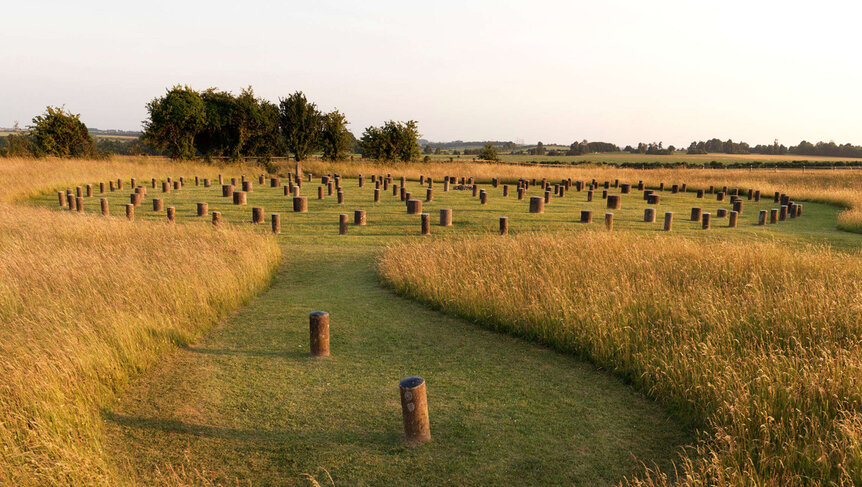Create a free profile to get unlimited access to exclusive videos, sweepstakes, and more!
Another mystical mystery has now been unearthed at Stonehenge

Just when you thought Stonehenge was mysterious enough, it got more mysterious.
Sacred sites don’t give up their secrets easily, but an international team of archaeologists led by University of Bradford's Vincent Gaffney have now unearthed a series of deep shafts encircling Durrington Walls, a Neolithic henge monument on Salisbury Plain, Wiltshire, nearly two miles from Stonehenge. These shafts had previously been dismissed as dewponds until they were re-examined and identified as something definitely made by humans. They form a circle 1.2 miles in diameter and are thought to have possibly been dug to hold massive wooden upright structures much like the standing stones at Stonehenge.
“The arrangement of these pits is interpreted as a distinct structure that was not necessarily intended to prefigure henge construction or emulate henge enclosure design,” said Gaffney, 50th Anniversary Chair of the School of Archaeological and Forensic Sciences in the Faculty of Life Sciences, in a study recently published in Internet Archaeology, adding that “These recent studies … provide new evidence for hitherto unknown features or monumental structures around the henge at Durrington Walls.”
Now known as the Durrington Anomalies, each of these shafts is about 16 feet deep and almost 33 feet in diameter. There was no heavy machinery 4,500 years ago. It does seem hard to fathom how people working with bone, wood, and stone tools could have pulled this off, until you remember that these were the same people who somehow moved enormous bluestones 150 miles from Wales to the site that would be Stonehenge. Another team of archaeologists who attempted to recreate that movement with similar amounts of weight suggested that the stones could have been rolled over there on logs. They also believed oxen were involved, since the manpower required would have been tremendous.
Gaffney believes that whether or not the shafts really are all that is left of ancient wooden totem poles, they signified one thing that was unexpected. Neolithic people could obviously count.
How these ditches were positioned suggests that the distance between the 20 shafts (there could be at least 10 more either still hiding somewhere or lost to time) had to be measured by hundreds of paces. The way that Durrington Walls is positioned right in the middle is not an accident.
What we do know is that Durrington Walls and Stonehenge were built with intent. Neolithic people would associate materials that could degrade, such as wood, mud, and straw, with the realm of the living, and seemingly immortal stone with the realm of the dead — as has been proven by previous archaeological studies. The river Avon separates them much like Lethe of Greco-Roman lore and other bodies of water in the underworld, like the ancient Egyptian belief that departed pharaohs rowed across celestial bodies of water to reach the underworld. Could it be that the Durrington Anomalies were meant to act as the boundary one had to cross into the world of the living? If so, were they also meant to keep the spirits of the departed where they belonged?
The answer to that remains hazy. Gaffney believes they must have had some sort of cosmological use that reveals Neolithic people as much more advanced than anyone could have guessed.
The cosmos ruled many ancient religions and rituals. Stonehenge itself was purposely built for the Sun to rise behind what is known as the heel-stone in the northeast horizon, so the first light of the summer solstice would glow in the heart of the henge. The opposite happens during the winter solstice, when the sun sets in the southwest horizon on the longest night of the year. It could be that hypothetical wooden posts which rose from the Durrington Anomalies were also arranged to coincide with the summer solstice or had some other type of astronomical association.
“The issues of astronomic alignments at Durrington Walls are complex,” Gaffney said. “Durrington Walls’ southern circle has a solstitial alignment to the southeast and the midwinter solstice, but, because of the sloping ground, this is not necessarily true for the northwest alignment. However, the short avenue linking Durrington Walls to the Avon may be aligned closely to the summer solstice sunset to the northwest.”
Many unanswered questions are still buried in the past, but this shows that we tend to underestimate our Neolithic ancestors when it comes to how advanced their civilizations really were. Who knows what else is hiding in what was once the world of the living — and the afterlife.



























